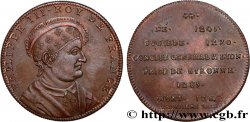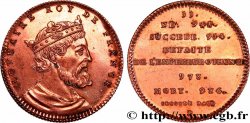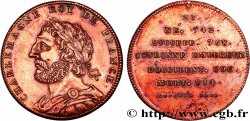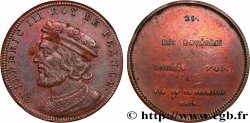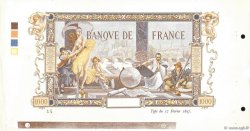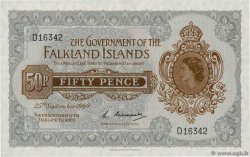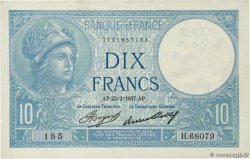fjt_741874 - METALLIC SERIES OF THE KINGS OF FRANCE Règne de PHILIPPE VI - 50 n.d.
35.00 €(Approx. 40.95$ | 30.10£)
Quantity
Add to your cart

Type : Règne de PHILIPPE VI - 50
Date: n.d.
Metal : copper
Diameter : 32 mm
Orientation dies : 12 h.
Weight : 12,02 g.
Edge : cannelée
Rarity : R2
Predigree :
Exemplaire provenant de la Collection MARINECHE
Obverse
Obverse legend : PHILIPPE VI ROY DE FRANCE.
Obverse description : Buste imaginaire couronné et drapé à droite.
Reverse
Reverse legend : 50 - NÉ 1292 - SUCCEDE 1328 - BATAILLE DE MONT CASSEL 1328 - MORT 1350 - TROISIEME RACE BRANCHE DE VALOIS / P..
Reverse description : en neuf lignes.
Commentary
Philippe VI de France, dit Philippe de Valois (né en 1293, mort le 22 août 1350) à Nogent le Roi, fut le premier roi de France de la branche collatérale des Valois. Son accession au trône en tant que roi de France déclencha la revendication sur ce trône d'Édouard III d'Angleterre et provoqua la guerre de Cent ans.
Surnommé de « roi trouvé », ce sobriquet lui fut donné peu après son couronnement lors de la bataille de Cassel du 23 août 1328 par les Flamands lesquels, avant la bataille, s'étaient moqués du roi de France en peignant un coq sur leur étendard avec cette inscription : Quand ce cocq icy chantera, le Roy trouvé cy entrera
Son accession sur le trône de France en 1328 découle d'un choix politique, fait en deux temps, à la mort de Louis X le Hutin en 1316 puis à celle de Charles IV en 1328, afin d'éviter que la couronne ne passe dans les mains d'un « étranger ». Édouard III d'Angleterre, pourtant petit-fils de Philippe le Bel, est ainsi évincé au profit du neveu de ce dernier.
Lors de son avènement, il doit aussi négocier avec Jeanne II de Navarre (1311-1349), fille de Louis X le Hutin qui a été évincée de la couronne de France en 1316 pour motif qu'elle est une femme (avancement de la "loi salique") mais également qu'elle est soupçonnée de batardise ou illégitimité, sa mère ayant été compromise dans le scandale de la tour de Nesle quand elle était mariée au dauphin, futur Louis X. Mais celle-ci revendique de manière parfaitement légitime la couronne de Navarre et les comtés de Champagne et de Brie que Philippe le Bel tenait de son épouse Jeanne 1ère de Navarre. N'étant pas lui-même descendant et héritier des rois de Navarre, comme l'étaient ses prédécesseurs, Philippe VI restitue donc le royaume de Navarre à son héritière légitime Jeanne de Navarre, mais refuse de lui céder la Champagne et la Brie redoutant d'être confronté à un parti trop puissant.
S'il accède à la tête de l'État le plus puissant d'Occident, il gouverne dans une période de crise qui conduit à la guerre de Cent Ans. Il manque de moyens financiers pour administrer son royaume, ce qui ne peut être obtenu que par la manipulation de la monnaie et des impôts supplémentaires, lesquels ne sont tolérés qu'en période de guerre. Il doit asseoir au plus vite sa légitimité. Il le fait en restaurant l'autorité royale en Flandre en écrasant les rebelles Flamands lors de la bataille de Cassel le 23 août 1328.
Par une habile politique diplomatique et matrimoniale, il contribue à augmenter l'influence du royaume à l'Est du royaume de France. Il rachète le Dauphiné pour le compte de son petit-fils, remarie son fils à une héritière potentielle de la Bourgogne et prend une option sur le comté de Provence.
Pour la suite de la biographie, voir http://fr.wikipedia.org/wiki/Philippe_VI_de_France.
Philip VI of France, known as Philip of Valois (born in 1293, died on August 22, 1350) in Nogent le Roi, was the first king of France of the collateral branch of the Valois. His accession to the throne as King of France triggered Edward III of England's claim to the throne and provoked the Hundred Years' War..
Nicknamed the \\\"found king\\\", this sobriquet was given to him shortly after his coronation at the Battle of Cassel on 23 August 1328 by the Flemish who, before the battle, had mocked the King of France by painting a rooster on their standard with this inscription: When this rooster crows here, the found King will enter here. His accession to the throne of France in 1328 resulted from a political choice, made in two stages, on the death of Louis X the Quarrelsome in 1316 and then on that of Charles IV in 1328, in order to prevent the crown from passing into the hands of a \\\"foreigner\\\".. Edward III of England, although the grandson of Philip the Fair, was thus ousted in favor of the latter's nephew..
Upon his accession, he also had to negotiate with Jeanne II of Navarre (1311-1349), daughter of Louis X the Quarrelsome, who had been ousted from the crown of France in 1316 on the grounds that she was a woman (advancement of the \\\"Salic law\\\") but also that she was suspected of bastardy or illegitimacy, her mother having been compromised in the scandal of the Tower of Nesle when she was married to the dauphin, the future Louis X. But the latter claims in a perfectly legitimate manner the crown of Navarre and the counties of Champagne and Brie that Philip the Fair held from his wife Joanna I of Navarre.. Not being himself a descendant and heir of the kings of Navarre, as were his predecessors, Philip VI therefore restored the kingdom of Navarre to his legitimate heiress Jeanne of Navarre, but refused to cede Champagne and Brie to her, fearing to be confronted with too powerful a party..
Although he became head of the most powerful state in the West, he governed during a period of crisis that led to the Hundred Years' War.. He lacks the financial means to administer his kingdom, which can only be obtained through coin manipulation and additional taxes, which are only tolerated in times of war.. He must establish his legitimacy as quickly as possible.. He did this by restoring royal authority in Flanders by crushing the Flemish rebels at the Battle of Cassel on 23 August 1328..
Through a skillful diplomatic and matrimonial policy, he contributed to increasing the influence of the kingdom in the East of the Kingdom of France.. He bought the Dauphiné for his grandson, remarried his son to a potential heiress of Burgundy and took an option on the county of Provence.
For the rest of the biography, see http://fr. Wikipedia. org/wiki/Philippe_VI_de_France
Surnommé de « roi trouvé », ce sobriquet lui fut donné peu après son couronnement lors de la bataille de Cassel du 23 août 1328 par les Flamands lesquels, avant la bataille, s'étaient moqués du roi de France en peignant un coq sur leur étendard avec cette inscription : Quand ce cocq icy chantera, le Roy trouvé cy entrera
Son accession sur le trône de France en 1328 découle d'un choix politique, fait en deux temps, à la mort de Louis X le Hutin en 1316 puis à celle de Charles IV en 1328, afin d'éviter que la couronne ne passe dans les mains d'un « étranger ». Édouard III d'Angleterre, pourtant petit-fils de Philippe le Bel, est ainsi évincé au profit du neveu de ce dernier.
Lors de son avènement, il doit aussi négocier avec Jeanne II de Navarre (1311-1349), fille de Louis X le Hutin qui a été évincée de la couronne de France en 1316 pour motif qu'elle est une femme (avancement de la "loi salique") mais également qu'elle est soupçonnée de batardise ou illégitimité, sa mère ayant été compromise dans le scandale de la tour de Nesle quand elle était mariée au dauphin, futur Louis X. Mais celle-ci revendique de manière parfaitement légitime la couronne de Navarre et les comtés de Champagne et de Brie que Philippe le Bel tenait de son épouse Jeanne 1ère de Navarre. N'étant pas lui-même descendant et héritier des rois de Navarre, comme l'étaient ses prédécesseurs, Philippe VI restitue donc le royaume de Navarre à son héritière légitime Jeanne de Navarre, mais refuse de lui céder la Champagne et la Brie redoutant d'être confronté à un parti trop puissant.
S'il accède à la tête de l'État le plus puissant d'Occident, il gouverne dans une période de crise qui conduit à la guerre de Cent Ans. Il manque de moyens financiers pour administrer son royaume, ce qui ne peut être obtenu que par la manipulation de la monnaie et des impôts supplémentaires, lesquels ne sont tolérés qu'en période de guerre. Il doit asseoir au plus vite sa légitimité. Il le fait en restaurant l'autorité royale en Flandre en écrasant les rebelles Flamands lors de la bataille de Cassel le 23 août 1328.
Par une habile politique diplomatique et matrimoniale, il contribue à augmenter l'influence du royaume à l'Est du royaume de France. Il rachète le Dauphiné pour le compte de son petit-fils, remarie son fils à une héritière potentielle de la Bourgogne et prend une option sur le comté de Provence.
Pour la suite de la biographie, voir http://fr.wikipedia.org/wiki/Philippe_VI_de_France.
Philip VI of France, known as Philip of Valois (born in 1293, died on August 22, 1350) in Nogent le Roi, was the first king of France of the collateral branch of the Valois. His accession to the throne as King of France triggered Edward III of England's claim to the throne and provoked the Hundred Years' War..
Nicknamed the \\\"found king\\\", this sobriquet was given to him shortly after his coronation at the Battle of Cassel on 23 August 1328 by the Flemish who, before the battle, had mocked the King of France by painting a rooster on their standard with this inscription: When this rooster crows here, the found King will enter here. His accession to the throne of France in 1328 resulted from a political choice, made in two stages, on the death of Louis X the Quarrelsome in 1316 and then on that of Charles IV in 1328, in order to prevent the crown from passing into the hands of a \\\"foreigner\\\".. Edward III of England, although the grandson of Philip the Fair, was thus ousted in favor of the latter's nephew..
Upon his accession, he also had to negotiate with Jeanne II of Navarre (1311-1349), daughter of Louis X the Quarrelsome, who had been ousted from the crown of France in 1316 on the grounds that she was a woman (advancement of the \\\"Salic law\\\") but also that she was suspected of bastardy or illegitimacy, her mother having been compromised in the scandal of the Tower of Nesle when she was married to the dauphin, the future Louis X. But the latter claims in a perfectly legitimate manner the crown of Navarre and the counties of Champagne and Brie that Philip the Fair held from his wife Joanna I of Navarre.. Not being himself a descendant and heir of the kings of Navarre, as were his predecessors, Philip VI therefore restored the kingdom of Navarre to his legitimate heiress Jeanne of Navarre, but refused to cede Champagne and Brie to her, fearing to be confronted with too powerful a party..
Although he became head of the most powerful state in the West, he governed during a period of crisis that led to the Hundred Years' War.. He lacks the financial means to administer his kingdom, which can only be obtained through coin manipulation and additional taxes, which are only tolerated in times of war.. He must establish his legitimacy as quickly as possible.. He did this by restoring royal authority in Flanders by crushing the Flemish rebels at the Battle of Cassel on 23 August 1328..
Through a skillful diplomatic and matrimonial policy, he contributed to increasing the influence of the kingdom in the East of the Kingdom of France.. He bought the Dauphiné for his grandson, remarried his son to a potential heiress of Burgundy and took an option on the county of Provence.
For the rest of the biography, see http://fr. Wikipedia. org/wiki/Philippe_VI_de_France








 Report a mistake
Report a mistake Print the page
Print the page Share my selection
Share my selection Ask a question
Ask a question Consign / sell
Consign / sell
 Full data
Full data